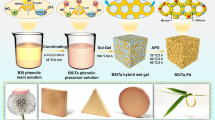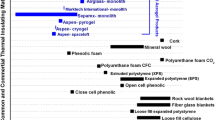Abstract
A C/SiO2/SiC ternary aerogel was prepared from a formaldehyde–catechol/silicon source via the sol−gel method, supercritical drying, and high-temperature carbothermal reduction. The effects of different carbon/silicon molar ratios on the microstructure, chemical composition, and mechanical and shielding properties of the C/SiO2/SiC aerogels were investigated. The fabricated aerogels exhibited low density of 0.118–0.271 g/cm3, low thermal conductivity of 0.044 to 0.089 W/(m∙K) and a high specific surface area of 774 m2/g. The aerogel exhibited electromagnetic interference shielding effectiveness (SE) properties; the maximum SE value was 24 dB over 12.4–18.0 GHz with an absorption-dominant shielding characteristic. To improve the mechanical properties of the ternary aerogel, novel SiCw-C/SiO2/SiC aerogel composites were prepared by adding different contents of SiC whiskers into precursor solutions. The mechanism affecting thermal and mechanical properties of aerogel composites was investigated. This composite having high strength and low thermal conductivity had potential applications in space shuttles and reusable carrier thermal protection materials.

The fabricated C/SiO2/SiC ternary aerogels exhibited low density of 0.118–0.271 g/cm3 and low thermal conductivity of 0.044−0.089 W/(m∙K). The aerogel exhibited electromagnetic interference shielding effectiveness (SE) properties; the maximum SE value was 24 dB over 12.4–18.0 GHz with an absorption-dominant shielding characteristic.
Highlights
-
C/SiO2/SiC aerogel exhibited electromagnetic interference shielding effectiveness property.
-
Novel SiCw-C/SiO2/SiC aerogel composites with high compressive strength and low thermal conductivity were successfully prepared.








Similar content being viewed by others
References
White RJ, Brun N, Budarin VL, Clark JH, Titirici MM (2014) Always look on the “light” side of life: sustainable carbon aerogels. Chemsuschem 7(3):670–689
Chen ZP, Ren WC, Gao LB, Liu BL, Pei SF, Cheng HM (2011) Three-dimensional flexible and conductive interconnected graphene networks grown by chemical vapour deposition. Nat Mater 10(6):424–428
Gui XC, Wei JQ, Wang KL, Cao AQ, Zhu HW, Jia Y, Shu QK, Wu DH (2010) Carbon nanotube sponges. Adv Mater 22(5):617–621
Jia XF, Dai BW, Zhu ZX, Wang JT, Qiao WM, Long DH, Ling LC (2016) Strong and machinable carbon aerogel monoliths with low thermal conductivity prepared via ambient pressure drying. Carbon 108:551–560
Frackowiak E, Beguin F (2011) Carbon materials for the electrochemical storage of energy in capacitors. Carbon 39(6):937–950
Omranpour H, Motahari S (2013) Effects of processing conditions on silica aerogel during aging: role of solvent time and temperature. J Non-Cryst Solids 379(4):7–11
Dorcheh AS, Abbasi MH (2008) Silica aerogel; synthesis, properties and characterization. Mater Process Technol 199(1):10–26
Leventis N, Sotiriouleventis C, Zhang AGH, Rawashdeh AMM (2002) Nanoengineering strong silica aerogels. Nano Lett 2(9):957–960
Kanamori K, Aizawa M, Nakanishi K, Hanada T (2007) New transparent methylsilsesquioxane aerogels and xerogels with improved mechanical properties. Adv Mater 19(12):1589–1593
Zu GQ, Shimizu T, Kanamori K, Zhu Y, Maeno A, Kaji H, Shen J, Nakanishi K (2018) Transparent, superflexible doubly cross-linked polyvinylpolymethylsiloxane aerogel superinsulators via ambient pressure drying. Acs Nano 12(1):521–532
Zu GQ, Kanamori K, Maeno A, Kaji H, Nakanishi K (2018) Superflexible multifunctional polyvinylpolydimethylsiloxane-based aerogels as efficient absorbents, thermal superinsulators, and strain sensors. Angew Chem Int Ed 130(31):9722–9727
Durães L, Ochoa M, Portugal A, Duarte N, Dias JP, Rocha N, Hernandez J (2010) Tailored silica based xerogels and aerogels for insulation in space environments. Adv Sci Technol 63(63):41–46
Wiener M, Reichenauer G, Braxmeier S, Hemberger F, Ebert HP (2009) Carbon aerogel-based high-temperature thermal insulation. Int J Thermophys 30(4):1372–1385
Feng JZ, Feng J, Jiang YG, Zhang CR (2011) Ultralow density carbon aerogels with low thermal conductivity up to 2000 °C. Mater Lett 65(23):3454–3456
Li KZ, Lan FT, Li HJ, Shen XT, He YG (2009) Oxidation protection of carbon/carbon composites with SiC/indialite coating for intermediate temperatures. Eur Ceram Soc 29(9):1803–1807
Moene R, Makkee M, Moulijn JA (1998) High surface area silicon carbide as catalyst support characterization and stability. Appl Catal A 167(2):321–330
Dey A, Kayal N, Chakrabarti O (2011) Preparation of porous SiC ceramics by an infiltration technique. Ceram Int 37(1):223–230
Kong Y, Shen XD, Cui S, Fan MH (2014) Preparation of monolith SiC aerogel with high surface area and large pore volume and the structural evolution during the preparation. Ceram Int 40(6):8265–8271
Lamouroux F, Bourrat X, Naslain R, Thebault J (1995) Silicon carbide infiltration of porous C–C composites for improving oxidation resistance. Carbon 33(4):525–535
Seraji MM, Ghafoorian NS, Bahramian AR, Alahbakhsh A (2015) Preparation and characterization of C/SiO2/SiC aerogels based on novolac/silica hybrid hyperporous materials. J Non-Cryst Solids 425:146–152
Wu XD, Shao GF, Shen XD, Cui S, Chen XB (2017) Evolution of the novel C/SiO2/SiC ternary aerogel with high specific surface area and improved oxidation resistance. Chem Eng J 330:1022–1034
Seraji MM, Ghafoorian NS, Bahramian AR (2016) Investigation of microstructure and mechanical properties of novolac/silica and C/SiO2/SiC aerogels using mercury porosimetry method. J Non-Cryst Solids 435:1–7
Assefa D, Zera E, Campostrini R, Soraru GD, Vakifahmetoglu C (2016) Polymer-derived SiOC aerogel with hierarchical porosity through HF etching. Ceram Int 42(10):11805–11809
Kong Y, Zhong Y, Shen XD, Cui S, Fan MH (2014) Effect of silica sources on nanostructures of resorcinol–formaldehyde/silica and carbon/silicon carbide composite aerogels. Micro Mesopor Mater 197:77–82
Naseri I, Kazemi A, Bahramian AR, Razzaghi KR (2014) Preparation of organic and carbon xerogels using high-temperature–pressure sol-gel polymerization. Mater Des 61(9):35–40
Du B, Hong CQ, Wang AZ, Zhou ST, Qu Q, Zhou SB, Zhang XH (2017) Preparation and structural evolution of SiOC preceramic aerogel during high-temperature treatment. Ceram Int 44(1):563–570
Leventis N, Sadekar A, Chandrasekaran N, Sotiriouleventis C (2010) Click synthesis of monolithic silicon carbide aerogels from polyacrylonitrile-coated 3D silica networks. Chem Mater 22(9):2790–2803
Koc R, Cattamanchi SV (1998) Synthesis of beta silicon carbide powders using carbon coated fumed silica. J Mater Sci 33(10):2537–2549
Yao JF, Wang HT, Zhang XY, Zhu W, Wei JP, Cheng YB (2007) Role of pores in the carbothermal reduction of carbon-silica nanocomposites into silicon carbide nanostructures. Phys Chem C 111(2):636–641
Chen K, Bao ZH, Du A, Zhu XR, Wu GM, Shen J, Zhou B (2012) Synthesis of resorcinol–formaldehyde/silica composite aerogels and their low-temperature conversion to mesoporous silicon carbide. Micro Mesopor Mater 149(1):16–24
Najafi A, Fard FG, Rezaie HR, Ehsani N (2012) Synthesis and characterization of SiC nano powder with low residual carbon processed by sol-gel method. Powder Technol 219(3):202–210
Wang B, Wang YD, Lei YP, Wu N, Gou YZ (2014) Hierarchically porous SiC ultrathin fibers mat with enhanced mass transport, amphipathic property and high-temperature erosion resistance. Mater Chem A 2(48):20873–20881
Ye CS, Zhang RB, An ZM, Wang BL (2018) A machinable carbon aerogel composite with a low thermal conductivity and enhanced mechanical properties. Adv Appl Ceram 117(8):468–475
Chen QJ, Long DH, Chen L, Liu XJ, Liang XY, Qiao WM, Ling LC (2011) Synthesis of ultrahigh-pore-volume carbon aerogels through a “reinforced-concrete” modified sol-gel process. J Non-Cryst Solids 357(1):232–235
Li YQ, Samad YA, Polychronopoulou K, Liao K (2015) Lightweight and highly conductive aerogel-like carbon from sugarcane with superior mechanical and EMI shielding properties. ACS Sustain Chem 3(7):1419–1427
Guo DM, Lu Y, Zhao YB, Zhang XT (2015) Synthesis and physicochemical properties of graphene/ZrO2 composite aerogels. RSC Adv 5(16):11738–11744
Liu QL, Gu JJ, Zhang W, Miyamooto Y, Chen ZX, Zhang D (2012) Biomorphic porous graphitic carbon for electromagnetic interference shielding. Mater Chem 22(39):21183–21188
Taki Y, Kitiwan M, Katsui H, Goto T (2017) Electrical conductivity of C-SiC and Si-SiC prepared by spark plasma sintering. Mater Today Proc 4(11):11441–11444
Fu R, Zheng B, Liu J, Weiss S, Ying JJ, Dresselhaus MS, Dresselhaus G, Satcher JH, Baumann TF (2003) Fabrication of activated carbon fibres/carbon aerogels composites by gelation and supercritical drying in isopropanol. Mater Res 18(12):2765–2773
Hou XB, Zhang RB, Fang DN (2017) Novel whisker-reinforced Al2O3 –SiO2 aerogel composites with ultra-low thermal conductivity. Ceram Int 43(12):9547–9551
Wang MR, Pan N (2009) Predictions of effective physical properties of complex multiphase materials. Mater Sci Eng R 63(1):1–30
Tang GH, Bi C, Zhao Y, Tao WQ (2015) Thermal transport in nano-porous insulation of aerogel: factors, models and outlook. Energy 90:701–721
Acknowledgements
This work was supported by the National Natural Science Foundation of China (11672031 and 11872103).
Author information
Authors and Affiliations
Corresponding author
Ethics declarations
Conflict of Interest
The authors declare that they have no conflict of interest.
Additional information
Publisher’s note: Springer Nature remains neutral with regard to jurisdictional claims in published maps and institutional affiliations.
Rights and permissions
About this article
Cite this article
An, Z., Ye, C., Zhang, R. et al. Multifunctional C/SiO2/SiC-based aerogels and composites for thermal insulators and electromagnetic interference shielding. J Sol-Gel Sci Technol 89, 623–633 (2019). https://doi.org/10.1007/s10971-019-04916-5
Received:
Accepted:
Published:
Issue Date:
DOI: https://doi.org/10.1007/s10971-019-04916-5




